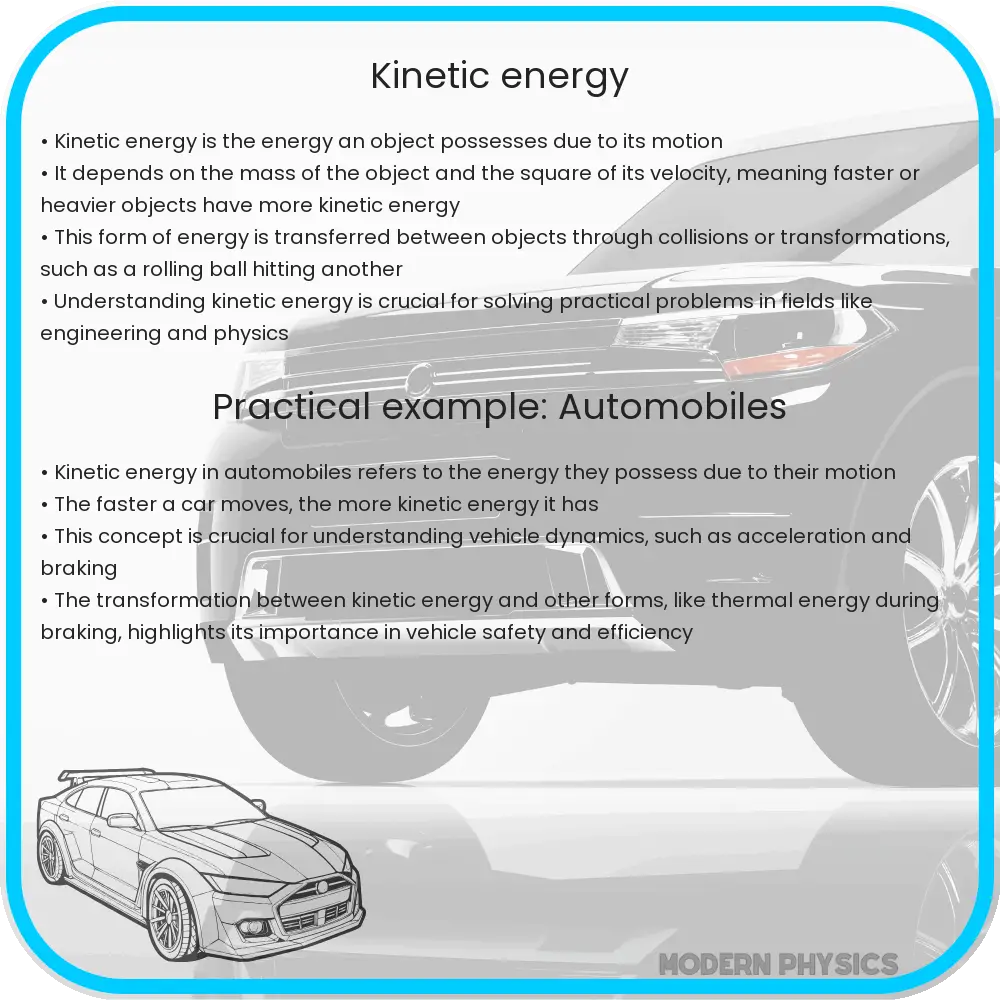Explore the fundamentals of kinetic energy, its calculations, and diverse applications in engineering, astronomy, and renewable energy.

Kinetic Energy: An Overview
Kinetic energy, a fundamental concept in physics, refers to the energy that an object possesses due to its motion. It is a dynamic form of energy, observable and quantifiable in every moving object, from the microscopic level of atoms to macroscopic entities like vehicles or celestial bodies.
Principles of Kinetic Energy
The principle of kinetic energy is derived from the work-energy theorem, which states that the work done on an object is equal to the change in its kinetic energy. This form of energy depends on two primary factors: the mass of the object (m) and its velocity (v). The standard formula for kinetic energy (\(KE\)) is expressed as:
\[KE = \frac{1}{2}mv^2\]
This equation implies that the kinetic energy of an object is directly proportional to its mass and the square of its velocity, meaning that even a small increase in speed significantly increases the kinetic energy.
Calculations of Kinetic Energy
Calculating kinetic energy is straightforward with the knowledge of an object’s mass and velocity. For instance, if a car weighing 1,000 kg is moving at a speed of 20 meters per second, its kinetic energy can be calculated as:
\[KE = \frac{1}{2} \times 1000 \times 20^2 = 200,000 \, Joules\]
This computation demonstrates how kinetic energy increases with speed, illustrating its quadratic relationship with velocity.
Applications of Kinetic Energy
Kinetic energy finds applications in various fields:
- Engineering: Understanding kinetic energy is crucial in designing vehicles, machinery, and structures to ensure safety and efficiency.
- Astronomy: It aids in calculating the energy of celestial objects, which is essential for space missions and studying the universe’s dynamics.
- Sports Science: Analyzing the kinetic energy of athletes can improve performance and reduce injury risks.
Moreover, kinetic energy plays a significant role in renewable energy sources, such as wind and hydroelectric power, where the motion of air and water is harnessed to generate electricity.
Further Insights into Kinetic Energy
In addition to its basic applications, kinetic energy extends to more complex systems. For instance, in thermodynamics, the kinetic energy of particles contributes to a substance’s overall internal energy, influencing its temperature and heat transfer properties.
Relativistic Kinetic Energy
At velocities approaching the speed of light, classical kinetic energy formulas no longer suffice. Here, relativistic kinetic energy comes into play, accounting for the effects of special relativity. The relativistic kinetic energy formula is more complex, incorporating the Lorentz factor (\(\gamma\)), which adjusts for these high speeds.
Conservation of Kinetic Energy
The law of conservation of energy, a fundamental principle in physics, states that energy cannot be created or destroyed, only transformed. In many physical processes, kinetic energy is converted to potential energy and vice versa, maintaining the total energy of the system. For instance, in a pendulum, kinetic energy transforms into potential energy at the highest point and back to kinetic energy as it descends.
Challenges and Future Prospects
One of the challenges in harnessing kinetic energy effectively lies in energy conversion and storage. Innovations in technology, such as improved batteries and energy capture methods, are crucial for the efficient use of kinetic energy in renewable energy systems.
Conclusion
Kinetic energy is a pivotal concept in understanding the dynamics of motion and energy transfer in various systems. Its principles and calculations underpin many scientific and engineering disciplines, contributing to advancements in technology, energy, and our understanding of the universe. As we continue to explore and innovate, the role of kinetic energy in emerging technologies and sustainable solutions will undoubtedly expand, offering exciting prospects for the future.
